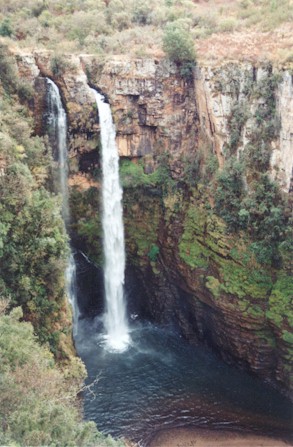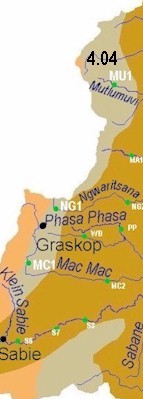|
The Sabie-Sand River System
Ecoregion 4.04
|
|
Ecoregion and River Characteristics
This ecoregion is in the lower reaches of the Drakensberg Escarpment, bordering on the Lowveld. Altitude is therefore much lower (400-1 500 m amsl) although terrain is still highly varied with mountainous relief. Mean annual rainfall varies from 600-1 200 mm, and temperatures much warmer than in ecoregion 4.03 (16-22°C). This is suitable for bushveld in the lower regions, although patches of afromontane forest are found in the upper slopes of this ecoregion. Sandy, loamy and clayey soils are found, which are well developed, although they may be leached. Geological formations include quartzites, granites, and sandstones.
Here the Sabie and Sand Rivers (and their tributaries) enter the Middleveld.
|
|
|
River characteristics include extensive bedrock runs (often with large granite boulders or cobbled beds) and slow, deep, sandy pools. Riparian vegetation consists of riparian old growth forest with shrubs and some reeds along the edge.
Present Ecological State
The Mac Mac River is in a
good
state, the Ngwaritsana River is
natural,
and the Mutlumuvi is
good
.

|

Drivers of Ecological Change (Land-use activities)
Trout and alien vegetation have an influence on the health of the Mac Mac River. Sewage from Graskop and impacts related to a sawmill also lower water quality in the
Mac Mac River.
Due to a waterfall that obstructs fish movement, no fish occur in the upper parts of the Ngwaritsana River. This is regarded as a natural situation.
|
|
|
Some of the streams that form part of the upper Mutlumuvi Catchment have started flowing for the first time in 60 years. This is largely attributed to the removal of alien trees by the Working for Water Programme and the Save the Sand initiative.
|
|
|
|
Desired Ecological State and Response by Resource Managers
The desired state of the Mac Mac and Ngwaritsana Rivers is
good
. The vision for developing the bigger area around headwaters of the Mutlumuvi into a conservation area, with only a relatively small portion reserved for community forestry, gives the Mutlumuvi a desired ecological state of
good
. At present the run off from this area resembles that of hardened surfaces in urban areas, and extensive rehabilitation and firm management is required to control this.
|





|























